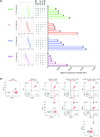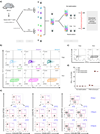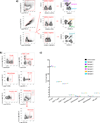A Simple, Versatile Antibody-Based Barcoding Method for Flow Cytometry
- PMID: 27439517
- PMCID: PMC4992625
- DOI: 10.4049/jimmunol.1600727
A Simple, Versatile Antibody-Based Barcoding Method for Flow Cytometry
Abstract
Barcoding of biological samples is a commonly used strategy to mark or identify individuals within a complex mixture. However, cell barcoding has not yet found wide use in flow cytometry that would benefit greatly from the ability to analyze pooled experimental samples simultaneously. This is due, in part, to technical and practical limitations of current fluorescent dye-based methods. In this study, we describe a simple, versatile barcoding strategy that relies on combinations of a single Ab conjugated to different fluorochromes and thus in principle can be integrated into any flow cytometry application. To demonstrate the efficacy of the approach, we describe the results of a variety of experiments using live cells as well as fixed and permeabilized cells. The results of these studies show that Ab-based barcoding provides a simple, practical method for identifying cells from individual samples pooled for analysis by flow cytometry that has broad applications in immunological research.
Conflict of interest statement
The authors declare that there are no conflicts of interest.
Figures






References
-
- Laerum OD, Farsund T. Clinical application of flow cytometry: a review. Cytometry. 1981;2:1–13. - PubMed
-
- Shapiro HM. Flow cytometric estimation of DNA and RNA content in intact cells stained with Hoechst 33342 and pyronin Y. Cytometry. 1981;2:143–150. - PubMed
-
- Shapiro HM. Flow cytometric probes of early events in cell activation. Cytometry. 1981;1:301–312. - PubMed
-
- Christensen ME, Jansen ES, Sanchez W, Waterhouse NJ. Flow cytometry based assays for the measurement of apoptosis-associated mitochondrial membrane depolarisation and cytochrome c release. Methods. 2013;61:138–145. - PubMed
MeSH terms
Substances
Grants and funding
LinkOut - more resources
Full Text Sources
Other Literature Sources

